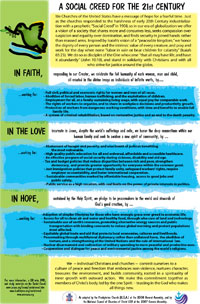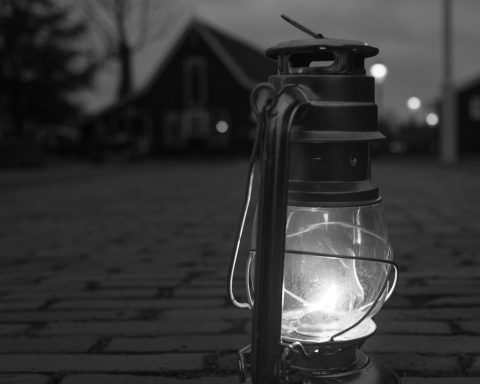
Words both denote and connote, which is to say that they both mean something and suggest a constellation of associated ideas, images, and feelings. Ecumenism means, simply, cooperation among Christian churches. The word connotes, however, a certain kind of cooperation among a certain subset of churches. The image it brings to mind probably looks like the black and white image below.
The 1948 founding of the World Council of Churches and the 1950 founding of the National Council of Churches are hardly recent events, but the history of mainline ecumenism in the United States stretches back much farther. It just didn’t always look like a solemn assembly of suited and robed clergy. Interdenominational revivals and benevolent organizations provided alternate models of ecumenical work before the rise of the institutional model in the twentieth century.
Revivals
The first event to unite the American colonies and many (though not all) of their churches was the 1740 preaching tour of evangelist George Whitefield. Ordained in the Church of England but affiliated with John and Charles Wesley’s Methodist movement, Whitefield preached a gospel of ‘new birth’ in churches and open-air settings from Philadelphia south to the Carolinas and then back north to New England. He was, without doubt, the most famous man in America in his time, regularly preaching to crowds larger than the population of the city he was visiting.
 Whitefield was a Calvinist, while the Wesley brothers were Arminian, but Whitefield did not believe this theological difference to be an unbridgeable gap. Neither was Whitefield concerned about the denominational differences present in colonial America. He would preach in pretty much any church that would have him – and outdoors near any church that would not! When the bishop’s representative in Boston argued that the Church of England was the only true church, Whitefield replied, “I saw regenerate souls among the Baptists, among the Presbyterians, among the Independents, and among the Church [of England] folks—all children of God, and yet all born again in a different way of worship: and who can tell which is the most evangelical?” By evangelical, it is important to note, Whitefield did not mean all of the characteristics associated with that term today, but simply actively committed to heartfelt faith in Jesus Christ. Whitefield found that kind of ‘evangelical’ Christian in the churches we now label ‘mainline.’
Whitefield was a Calvinist, while the Wesley brothers were Arminian, but Whitefield did not believe this theological difference to be an unbridgeable gap. Neither was Whitefield concerned about the denominational differences present in colonial America. He would preach in pretty much any church that would have him – and outdoors near any church that would not! When the bishop’s representative in Boston argued that the Church of England was the only true church, Whitefield replied, “I saw regenerate souls among the Baptists, among the Presbyterians, among the Independents, and among the Church [of England] folks—all children of God, and yet all born again in a different way of worship: and who can tell which is the most evangelical?” By evangelical, it is important to note, Whitefield did not mean all of the characteristics associated with that term today, but simply actively committed to heartfelt faith in Jesus Christ. Whitefield found that kind of ‘evangelical’ Christian in the churches we now label ‘mainline.’
___________________________________________
The first event to unite the American colonies and many (though not all) of their churches was the 1740 preaching tour of evangelist George Whitefield.
___________________________________________

Interchurch cooperation persisted in later revivals. The 1801 gathering at Cane Ridge, Kentucky, that is often considered the start of the Second Great Awakening featured Presbyterian, Baptist, and Methodist preachers. The folks who traveled for miles to participate in such camp meetings might go home to attend any one of those churches, or to hear whichever traveling preacher happened to include their area on his circuit. Denominational boundaries were not firm on the scarcely churched American frontier, though this did not mean that laypeople were unaware of doctrinal differences. Perhaps as common as joint revival meetings were debates and stump speeches at which preachers took sides on such controversial issues as infant baptism. Denominational loyalties tended to sharpen once towns built multiple churches.
One exception to that trend of denominational differentiation were the many “Plan of Union” churches founded under an 1801 agreement between the Congregationalists and Presbyterians. Both churches embraced a Calvinist faith, and some Congregationalists had adopted a polity similar to that of the Presbyterians. The Plan of Union also joined the churches’ energies for foreign mission work under the auspices of the American Board of Commissioners for Foreign Missions (ABCFM). “Presbygational” cooperation proceeded in church planting, missions, and the founding of colleges until Congregationalists pulled out of the partnership in 1852.
Benevolent Organizations
The ABCFM was just one of an array of interdenominational benevolent organizations founded in the early 19th century. Here is a list of several of the more prominent organizations, by founding year:
- 1806 – American Board of Commissioners for Foreign Missions
- 1816 – American Bible Society
- 1816 – American Colonization Society
- 1824 – American Sunday School Union
- 1825 – American Tract Society
- 1826 – American Home Missionary Society
- 1826 – American Temperance Society
- 1833 – American Anti-Slavery Society
 The founding of the American Bible Society gives a good sense of the church and social connections of the men—and they were predominantly men—who supported these efforts to spread the gospel and ameliorate social ills. As recorded in a centennial history of the gathering, “Mr. Joshua M. Wallace, of Burlington, New Jersey, an Episcopalian and a leading member of the New Jersey Bible Society, was chosen chairman of the Convention. Rev. Dr. John B. Romeyn, delegate from the New York Bible Society, pastor of the Cedar Street Reformed Church; and Rev. Dr. Lyman Beecher, the father of ‘all the Beechers,’ a young man who as pastor of the Congregational Church at Litchfield, Connecticut, had already fought well as a champion of temperance among the clergy, were appointed secretaries of the convention.” Also present were a Quaker educator, another Episcopal minister, two more Congregationalists, the pastor of Brick Presbyterian Church in New York, the future chief justice of New Jersey, a distinguished Quaker surgeon, and the novelist James Fennimore Cooper.
The founding of the American Bible Society gives a good sense of the church and social connections of the men—and they were predominantly men—who supported these efforts to spread the gospel and ameliorate social ills. As recorded in a centennial history of the gathering, “Mr. Joshua M. Wallace, of Burlington, New Jersey, an Episcopalian and a leading member of the New Jersey Bible Society, was chosen chairman of the Convention. Rev. Dr. John B. Romeyn, delegate from the New York Bible Society, pastor of the Cedar Street Reformed Church; and Rev. Dr. Lyman Beecher, the father of ‘all the Beechers,’ a young man who as pastor of the Congregational Church at Litchfield, Connecticut, had already fought well as a champion of temperance among the clergy, were appointed secretaries of the convention.” Also present were a Quaker educator, another Episcopal minister, two more Congregationalists, the pastor of Brick Presbyterian Church in New York, the future chief justice of New Jersey, a distinguished Quaker surgeon, and the novelist James Fennimore Cooper.
___________________________________________
By taking the long view and setting aside some of the connotations of the word ‘ecumenical’, we can see Christian collaboration in new places, springing from a deep vitality.
___________________________________________
The American Bible Society was dedicated to the efficient printing and distribution of Bibles. By the 1860s, the group regularly printed more than 1 million Bibles a year, with the goal of placing them in every American home and school. To facilitate interdenominational harmony, ABS Bibles were printed “without note or comment,” meaning that there were no marginal glosses to guide the reader’s interpretation. American Protestants of all stripes rallied around this unadorned King James Bible—especially after some Roman Catholics protested the requirement that their children study such a thoroughly Protestant Bible in the public schools. (Roman Catholics favored the Douay-Rheims English translation, and they also believed that the Bible should be read under the guidance of the church.) Ecumenical cooperation could be inspired by a common enemy as much as by a common task.
Ecumenical Institutions
In the twentieth century, church unity came to be seen by some Protestants not only as a means to an end—evangelism, for example, or curbing vices such as slavery and drunkenness—but as a worthy goal in itself. The first major institution devoted to this purpose was the Federal Council of Churches, founded in Philadelphia in 1908. Its membership included several branches of the Methodist Episcopal Church, black and white; the northern and southern branches of the Presbyterian Church; the Disciples of Christ/Christian Church; Quakers; Moravians; Baptists; Congregationalists; and a variety of German and Dutch ethnic churches. The Federal Council was perhaps best known for the 1908 “Social Creed of the Churches,” which focused on improving industrial conditions. The document ended with the ecumenical invitation, “To the toilers of America and to those who by organized effort are seeking to lift the crushing burdens of the poor, and to reduce the hardships and uphold the dignity of labor, this council sends the greeting of human brotherhood (sic) and the pledge of sympathy and of help in a cause which belongs to all who follow Christ.”

The Federal Council merged with other ecumenical organizations to form the National Council of Churches in 1950. Its membership expanded to include Lutherans, Episcopalians, and several Orthodox Churches. The Christian Century, which had become by the early 1920s the unofficial journal of liberal Protestantism, declared, “The National Council will give the churches a voice to which attention must be paid. It will provide a platform on which cooperative Protestantism can speak to ‘this nation under God.’” A banner bearing those last four words dominated the stage at the opening convention, spelling out the group’s ambitions in letters 10 feet high.
Like the Federal Council before it, the NCC took a liberal or progressive stance on political topics such as civil rights, environmentalism, the economy, and world peace. The organization’s opposition to the Vietnam War was especially strong, and especially divisive, as recounted by historian Jill Gill in her 2012 book Embattled Ecumenism. Conservatives accused the NCC of being soft on communism, many laypeople complained that their churches had become too political, and politicians, most notably President Richard Nixon, cut off the access to Washington elites that ecumenical Protestant leaders had previously enjoyed. The NCC’s budget, staff, and prominence waned. In 2013, it was forced to leave its headquarters in the towering New York City building dubbed the ‘God Box’. Now housed in an office suite in Washington, D.C., the NCC continues its advocacy, currently focusing on mass incarceration and interfaith peace efforts.
Ecumenism Today

Photo: Wikimedia User Americasroof, CC 3.0
Mainline ecumenism hasn’t always conformed to the mid-20th century institutional model, and it is unlikely to do so, except on a small scale, in the future. However, even as that model has declined, elements of older models have reappeared. As churches, particularly in rural areas, face declining memberships, a version of the old Congregational-Presbyterian Plan of Union has returned, yielding congregations affiliated with two, three, or even four denominations (see Hartford Institute Report). While the circumstances producing these federated churches are often unhappy ones of division or decline; at the same time but, on the positive side, they do embody an ecumenical vision that leaders in the 1950s and ‘60s dreamed about.
Similarly, while the American Bible Society is a shadow of its former self (it, too, recently left its New York headquarters), as a category, interdenominational benevolent organizations continue to thrive. The largest of these ‘parachurch’ organizations appeal mostly to evangelicals – organizations such as World Vision, Compassion International, Samaritan’s Purse, and Young Life. However, some – such as the International Justice Mission – attend to causes supported equally by mainline Christians.
By taking the long view and setting aside some of the connotations of the word ‘ecumenical’, we can see Christian collaboration in new places, springing from a deep vitality. The downsizing of the ‘God Box’ leaves open many possibilities for ecumenical work.
*****
AUTHOR BIO: Elesha Coffman is assistant professor of church history at the University of Dubuque Theological Seminary and author of The Christian Century and the Rise of the Protestant Mainline (Oxford).





Unbound Social